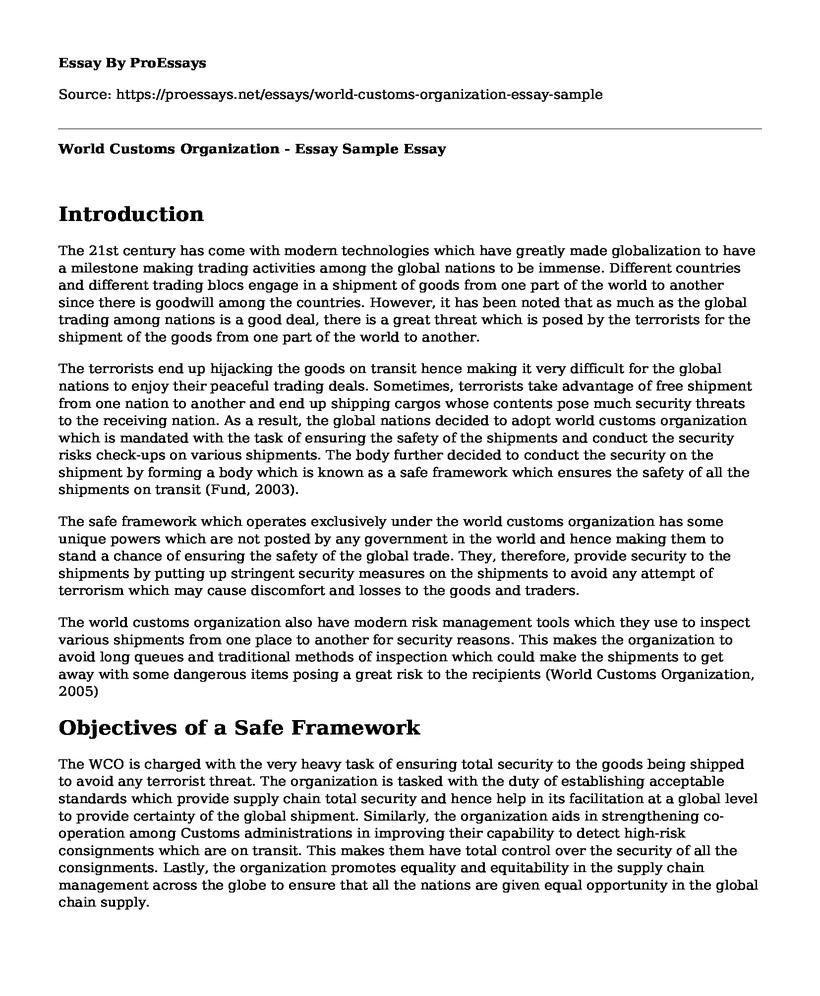Introduction
The 21st century has come with modern technologies which have greatly made globalization to have a milestone making trading activities among the global nations to be immense. Different countries and different trading blocs engage in a shipment of goods from one part of the world to another since there is goodwill among the countries. However, it has been noted that as much as the global trading among nations is a good deal, there is a great threat which is posed by the terrorists for the shipment of the goods from one part of the world to another.
The terrorists end up hijacking the goods on transit hence making it very difficult for the global nations to enjoy their peaceful trading deals. Sometimes, terrorists take advantage of free shipment from one nation to another and end up shipping cargos whose contents pose much security threats to the receiving nation. As a result, the global nations decided to adopt world customs organization which is mandated with the task of ensuring the safety of the shipments and conduct the security risks check-ups on various shipments. The body further decided to conduct the security on the shipment by forming a body which is known as a safe framework which ensures the safety of all the shipments on transit (Fund, 2003).
The safe framework which operates exclusively under the world customs organization has some unique powers which are not posted by any government in the world and hence making them to stand a chance of ensuring the safety of the global trade. They, therefore, provide security to the shipments by putting up stringent security measures on the shipments to avoid any attempt of terrorism which may cause discomfort and losses to the goods and traders.
The world customs organization also have modern risk management tools which they use to inspect various shipments from one place to another for security reasons. This makes the organization to avoid long queues and traditional methods of inspection which could make the shipments to get away with some dangerous items posing a great risk to the recipients (World Customs Organization, 2005)
Objectives of a Safe Framework
The WCO is charged with the very heavy task of ensuring total security to the goods being shipped to avoid any terrorist threat. The organization is tasked with the duty of establishing acceptable standards which provide supply chain total security and hence help in its facilitation at a global level to provide certainty of the global shipment. Similarly, the organization aids in strengthening co-operation among Customs administrations in improving their capability to detect high-risk consignments which are on transit. This makes them have total control over the security of all the consignments. Lastly, the organization promotes equality and equitability in the supply chain management across the globe to ensure that all the nations are given equal opportunity in the global chain supply.
Pillars of the Safe Framework
The safe framework is built in two main pillars which involve a set of standards which are basically consolidated to guarantee ease in understanding the rapid international implementation of chain supply to mean the 21st-century demands. These pillars are Customs-to-Customs network arrangements and Customs-to-Business partnerships. The two pillars above acts as a strong foundation upon which the world customs organization is based on to ensure the security of the shipments as noted by (United States. Congress. Senate. Committee on Finance, 2006)
Border Management
The WCO has developed an elaborate risk and security management systems which are able to detect any form of insecurity in a consignment which has acted as a major milestone in the success of the WCO operations globally. Due to the unique powers which they possess, they are not affected by border trade laws and are thus able to come up with uniform laws to control various shipments.
References
Fund, I. M. (2003). Changing Customs: Challenges and Strategies for the Reform of Customs Administration. Washington, DC: International Monetary Fund.
United States. Congress. Senate. Committee on Finance. (2006). Authorization of customs and trade functions: hearing before the Committee on Finance, United States Senate, One Hundred Ninth Congress, second session, April 26, 2006.
World Customs Organization. (2005). Global Information and Intelligence Strategy. Author.
Cite this page
World Customs Organization - Essay Sample. (2022, Nov 23). Retrieved from https://proessays.net/essays/world-customs-organization-essay-sample
If you are the original author of this essay and no longer wish to have it published on the ProEssays website, please click below to request its removal:
- Building End-User Relationships for Manufacturing Firms Essay
- The Anonymity of Data Essay
- Essay Sample on Leadership in Hydro Generation
- Essay Sample on Corporate Cultures
- Expert Systems: AI Technologies for Human/Organizational Behaviors - Essay Sample
- Paper Example on Struggle for Power & Supremacy: Who's Ahead?
- Managing Troubled Projects: 3-Step Plan & Escalation Plan - Essay Sample







